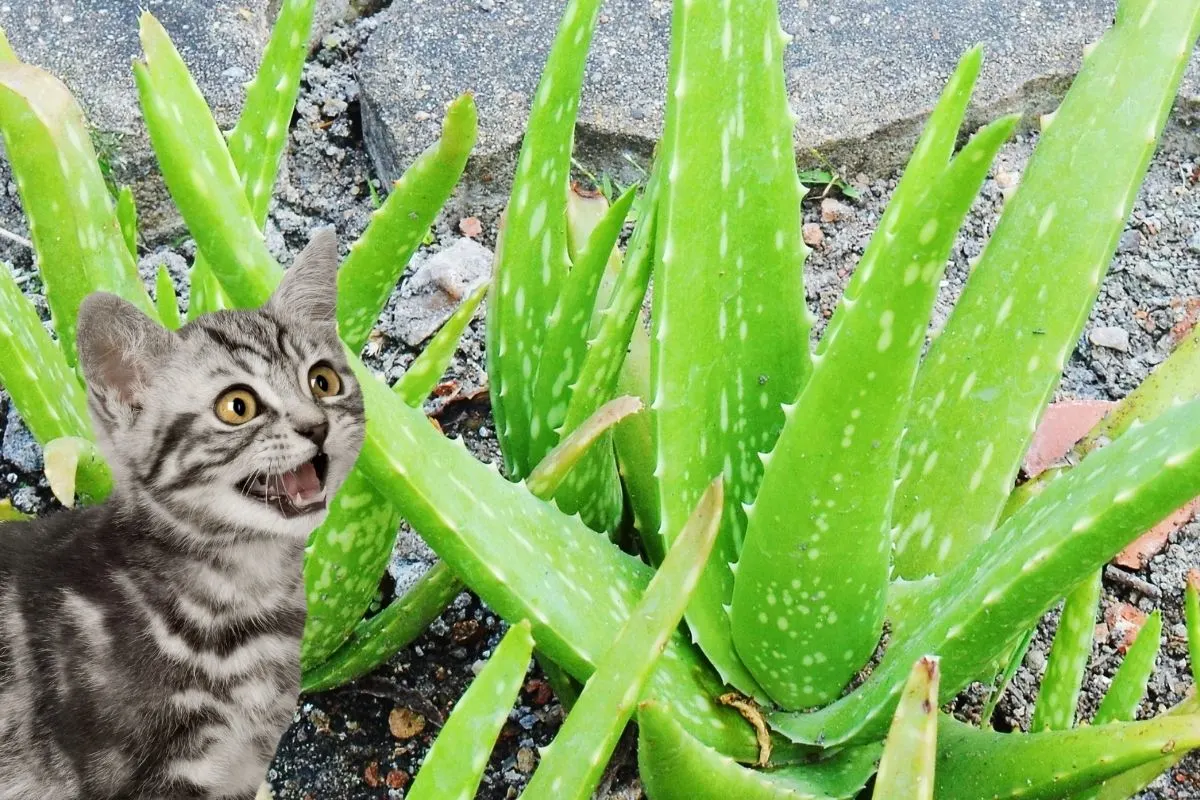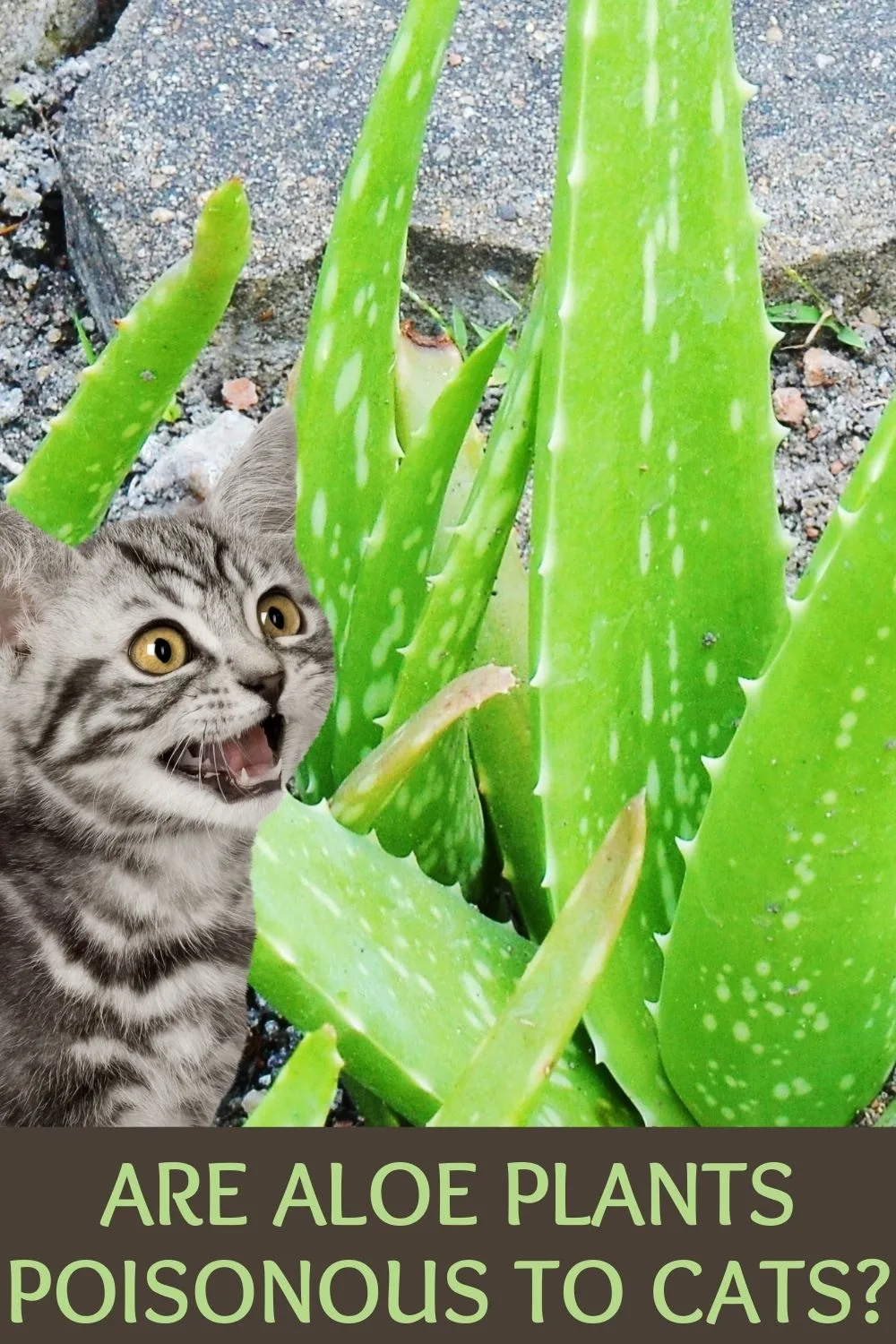There is an astonishingly long list of plants poisonous to cats! So, are aloe plants poisonous to cats? If you are a keen gardener and cat lover, it’s best to know which ones to avoid – particularly if your feline likes to chew on things. Aloes make a beautiful, feature-rich addition to gardens in hot, dry climates where water is scarce and requires very little maintenance.
Aloe plants are only poisonous to cats if they chew on or eat bits of them. The latex in the leaves can make your cat sick with diarrhea, vomiting, and lethargy, but cats seldom eat enough of the plant to cause more severe symptoms. To be safe, you should keep your cat away from aloes.

Aloe plants can be spectacular when in bloom, especially if planted en masse. Aloes are succulents with fleshy leaves often edged with thorny spikes or teeth. They are popular as indoor and outdoor plants and range in size from a couple of inches to the height of a small tree.
Aloe Vera
There are more than five hundred species of Aloes, but the one familiar to most people is the widely cultivated Aloe vera. It is sometimes called the “true aloe” because the word “vera” means “true” in Latin. It’s also on the list of toxic plants when it comes to houseplants and cats.
Aloe vera has several health benefits, and the gel can be applied to soothe skin and help heal wounds, but some parts of the plant are toxic to cats.
You shouldn’t be tempted to munch on the plant unless you want diarrhea, stomach cramps, and other unpleasant gastrointestinal symptoms. These are the same symptoms your furry friends will experience if they eat them, too.
It is a virtually stemless perennial with peaked, elongated leaves ranging from a couple of centimeters to three meters long. Aloe vera is prized for its anti-inflammatory, anti-viral, antimicrobial, and fungicidal properties in humans, but you should keep it away from your feline.
The aloe plant produces tall spikes of striking bright yellow, orange, or coral blooms. But be aware that aloe vera is now considered an invasive species in many regions of the world because it has escaped cultivation and is very hardy in warmer climates.
Related: List of plants that are poisonous to cats.
Why Would Your Cat Chew On Your Aloes?
Cats are notorious for their curiosity, and one of the ways they express it is by nibbling on things in their environment. The teeth or spikes on aloe leaves may be a sufficient deterrent in some cases, but not always. Cats can be pretty persistent, especially if they are bored.
Here are some reasons cats chew on plants:
- boredom
- stress
- because they are lacking in a nutrient (this is a theory)
- to help ease an upset tummy (another theory)
- to help reduce intestinal parasite load (one more theory)
And sometimes it is as simple as them being fun to play with. Aloe is a common houseplant (how to care for aloe vera), but it may not be a good idea if you have cats.
It’s best not to keep aloes as potted indoor plants if you have a cat. You can always keep your cat indoors if you have aloes in the garden, but keeping your cat outdoors defeats the object of sharing your home with a pet.
Many cat owners complain that their cats regularly decimate their houseplants, including by chewing on them. It’s best to keep planters of pet grass indoors to satisfy their need for greens and distract them from other houseplants. This organic cat grass kit makes it easy to add it to your home.
If you earnestly desire to keep aloes indoors, put them out of the cat’s reach. Adding a few indoor hanging baskets may be the next safest alternative to banning aloes from your home altogether.
Cats often like to dig in the soil around houseplants and garden plants, which brings them near plants they may be tempted to chew. Putting rocks, shells, and rough stones around the base of pot plants will discourage them from going there.
Fortunately, aloes do well in rockeries and other stony places outdoors where there isn’t much topsoil for a cat to dig. You can also surround your aloes with decorative stones, bits of broken tiles, brick, and other objects with rough surfaces to reduce their appeal to cats.
The Toxic Element Of Aloe Vera Plants
When you break an aloe leaf open, you will notice two things. First, a clear gel runs through the middle of the leaf. Second, at the broken edges of the leaf surface, a white or yellow latex-like substance exudes from the leaf’s skin. Latex is a harmful element contained in this plant.
It contains a toxin called aloin that’s been used for centuries as a human laxative. In large doses, all laxatives can be harmful to humans. The plant is not toxic to humans unless ingested in large quantities, and the same applies to cats. However, cats are much smaller than humans, so they need to consume less of the plant to experience its harmful effects.
The gel and the latex contain different chemical components commonly used for medical purposes. The leaf extract, consisting of the gel, the latex, and other plant parts, contains over two hundred chemical components.
Symptoms from ingesting aloe plants
There are many symptoms your cat might display if eating your plants. They range from stomach pain to kidney failure in the most extreme cases. A vet will know the clinical signs to look for and how to treat your cat for contact with poisonous plants.
If you suspect your cat has eaten your aloe, call the vet immediately or take her to an after-hours emergency vet. Pet owners know it’s better to be safe than sorry about your feline friends. Let’s look at some of these symptoms in more detail.
The Effects Of Ingestion of Aloe Vera Plants
Aloe vera has been used for thousands of years to treat various human ailments, and ancient civilizations called it the plant of immortality. However, this does not mean you will live forever if you consume the leaves or other plant parts.
These days, it is used in various foods, cosmetics, health products, and complementary and alternative medicine. Many of these products only use the gel part of the plant, not the latex.
You should avoid Aloe products that contain whole leaf extract because this includes latex, which can cause diarrhea and other unpleasant symptoms. In the case of aloe latex, case reports in humans have shown that prolonged use can cause diarrhea, vomiting, abdominal pain, dilation of the colon, and an increased risk of colon cancer.
Touching or brushing against an aloe may get you a few unwelcome scratches, but that’s it. Ingestion is where the danger lies. Fortunately, most cats don’t usually eat enough of the plant to kill them, but it can make them sick.
If your cat has chewed on an aloe leaf in your home or garden, you may see one or more of the following:
- vomiting
- diarrhea, which may become bloody
- irritation of the mucous membranes in the mouth and throat
- lethargy
- change in the color of urine
- tremors – rarely
- anorexia – i.e. decreased appetite or refusing food
- kidney damage in extreme cases
The gel from an aloe plant is not generally toxic to cats, and some veterinary products use it to soothe burns, scratches, eczema, skin infections, and bruises. The gel is rich in vitamins B12, C, and E and can help maintain a healthy digestive system when eaten in small quantities.
However, you should never add aloe plant parts from your garden to your cat’s food. You should only use products recommended by a veterinarian for your cat.
So, Are Aloe Plants Poisonous To Cats?
Aloes are toxic to cats, so you should think twice before keeping them as houseplants unless you are sure you can keep your cat away. When grown outdoors, aloes are less likely to attract your cat’s attention, especially if the base of the plants is covered with rocks. If your cat is sick and you suspect it has nibbled on an aloe, immediately take it to the vet. Professionals will know what to do and how to assess your pet for potential dangers.
As you can see, this is an indoor plant that, although it has medicinal purposes for humans, can be dangerous to your cat. The only way to be 100% certain your cat won’t get sick is to prevent him from having any access to it. If your cat isn’t a climber, this can be done by putting the plants up high. Other people put them inside cages or behind wire barriers the cats cannot access. You can create boundaries to protect your cats in many fun, creative ways.
It has the added bonus of protecting your plants since cats chewing on them can also damage or even kill them. Do you have any advice you’d want to add for people who own cats and aloe plants?

